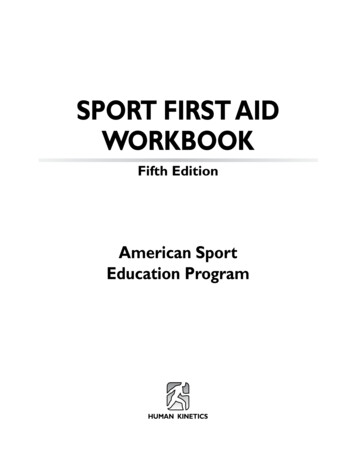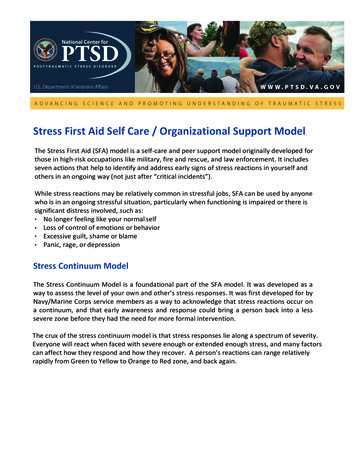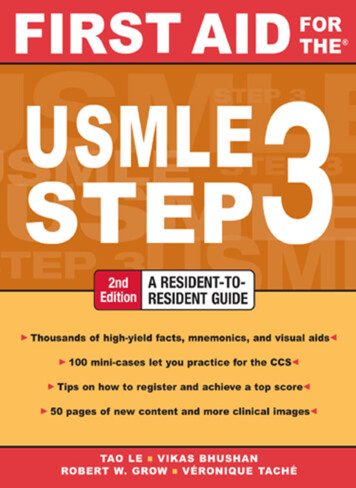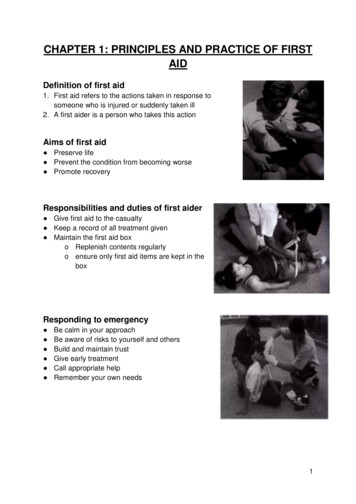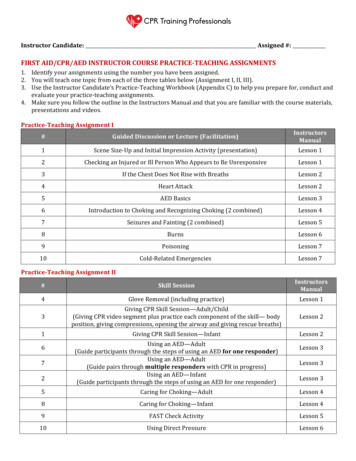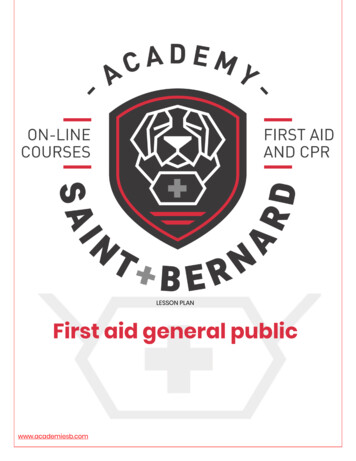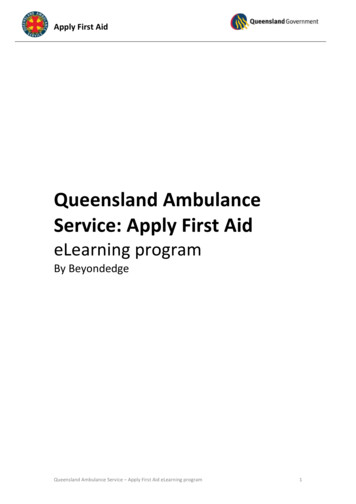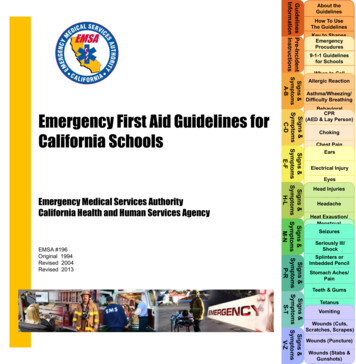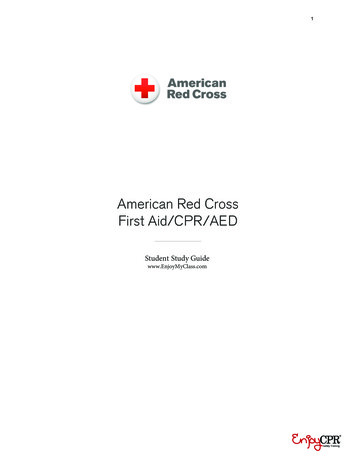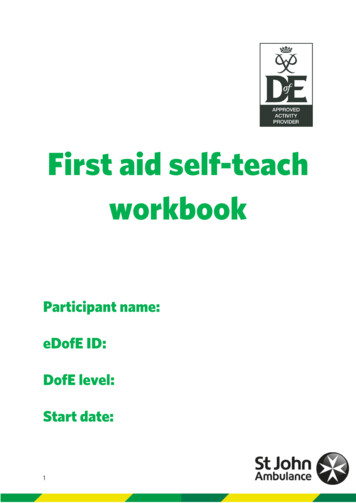
Transcription
First aid self-teachworkbookParticipant name:eDofE ID:DofE level:Start date:1
The Duke of Edinburgh’s Award(DofE) and St John AmbulanceA workbook for using first aid from St John Ambulance for your DofE skillsection.Thank you for choosing the very important skill of first aid for your DofE award. St JohnAmbulance teaches people first aid so they can be the difference between life and deathand that includes you.By choosing to learn first aid you are not only developing a new talent but you will alsoboost your self-esteem, develop practical and social skills and learn how to set and rise toa challenge. If this isn’t enough, it should also be good fun too!The DofE first aid self-teach workbook will give you everything you need to learn lifesavingskills at your own pace as part of your DofE award. You will find suggested activities,worksheets and case studies in this workbook which will enable you to put together yourown personalised schedule of activity, to help meet the aim(s) of your DofE section.TimescalesEach activity should last on average one hour per week for the minimum times suggestedbelow. This pack is specifically designed for the Bronze award, lasting three months,however this can be extended to meet the below timelines for the Silver and Gold awards.LevelMinimum timeBronze 3 to 6 monthsSilver6 to 12 monthsGold6 to 18 monthsNotesYou need to do one of your Volunteering, Physical or Skillssections for six months, the others for three.You need to do either the Physical or Skills section for sixmonths, the other for three. If you haven’t achieved yourBronze award you must extend your Volunteering or thelonger of your Physical or Skills sections to 12 months.You need to do either the Physical or Skills section for 12months, the other for six. If you haven’t achieved your Silveraward you must extend your Volunteering or the longer ofyour Physical or Skills sections to 18 months.I will be learning first aid for the skills section of myDofE award for months.2
Choosing your AssessorJust like every section of your DofE award you will need to enlist the help of an Assessorfor this section. The Assessor’s role is to check and assess what you are doing for anactivity. They should be a skilled, qualified or experienced person on the topic of first aid.For example, you may ask a St John Ambulance volunteer or anyone who holds a valid firstaid certificate, such as a teacher, youth leader or a health care professional (such as aparamedic, nurse or Doctor). It is important you share your completed workbook with yourAssessor when you have finished the section.My Assessor is:Assessor’s guidance notesThank you for your time and commitment in offering to assess the Skills section of thisparticipant’s DofE programme. For this section of their DofE programme, the participant has toshow development of practical, social or personal skills over a set period of time: first aidencompasses all of this. The participant will need to regularly learn and practice first aid, averagingat least one hour per week.In your role you will help the participant in the following ways: Help them set some goals and understand what they want to get out of learning first aid. Act as a subject matter expert in first aid by providing advice, supervision, feedback andtraining as needed. This could be virtually such as looking through answers on a first aidworksheet or face to face such as showing the correct technique for the recovery position. Review all of the work the participant completes including case studies, worksheets,quizzes, posters, etc. Support and encourage the participant while they are learning a new skill. Monitor progress. Do a final assessment at the end which should include the practical demonstration of a firstaid skill such as treating a major bleed.Participants meet the DofE requirements if they have undertaken their activity regularly, averagingat least one hour per week, over the agreed timescales and have demonstrated effort,perseverance and improvement.Once they have completed this you should produce an Assessor’s report. What you write willcelebrate the achievement of the participant and will form part of their permanent record of theirDofE programme. With this in mind please make your comments personal, positive and engaging.Remember to include the activity start and end dates.To enter your report online, visit www.DofE.org/assessor and follow the instructions. You will needthe participant’s name, their eDofE ID number, their DofE level and the section you are assessing.For more information and support please speak to your DofE Leader or contact DofE@sja.org.uk3
ActivityThe following table provides a programme for a three month DofE Skills section. Theprogramme you develop should be relevant and appropriate to you and can include manyother different activities, providing your programme averages at least one hour per week.Remember, first aid is a practical skill so the more you physically practice these skills andtechniques the better. Completing a first aid course is highly recommended to ensure youcan have supervision from an expert in first aid who can check your skills.As you go through the programme ensure you are gathering evidence to upload intoeDofE. For example, you could upload photos of you: practicing treating a patient; photosof completed worksheets; write ups of what you have learnt; or certificates etc.Week 1Coping in an emergencyKeeping safe, emergency calls, communication and casualty careWeek 2Primary survey and management of an unresponsive casualtyDR ABC and recovery positionWeek 3Introduction to resuscitationCardiopulmonary resuscitation (CPR) & Automated External Defibrillator (AED)Week 4Minor injuries, bleeding and shockMinor and severe bleeds, abrasions, blisters, splinters and shockWeek 5Bites, stings and allergic reactionsBites and stings and recognition and management of an allergic reactionWeek 6Bone, muscle and joint injuriesFractures, sprains and strainsWeek 7Burns and scaldsDifferent types of burns and management of a casualty who has burns or scaldsWeek 8Extremes of temperatureUnderstanding exposure to high and low temperaturesWeek 9Foreign objects and poisonsExposure to poisons and incidences of foreign objectsWeek 10Head injuries and spinal injurySpinal and head injuryWeek 11Airway emergenciesAsthma and chokingWeek 12Chest painHeart attack and angina attackWeek 134Case studies
Week 1 - Coping in an emergencyKeeping safe, emergency calls, communication and casualty care1Fill in the gaps using the following words (each may be used more than once):help rmation emergency aidbystandersassessIf you come across an emergency situation when someone has had anor has been , as a first aider you must quickly thesituation. It is very important to find out what has happened. You must make sure that youremove any to the , any or to. Never rush straight in to help, as you may make the situation worse ifyou do not realise the . For example, many people panic when they seean accident, run straight into the road and get themselves by a passingcar. Once you are sure that there is no further danger, you should check thefrom the casualty to decide if they are responsive or not. Theappropriate should then be applied. Once you have gathered all theyou need, get .2Unscramble the words to find out how to cope in an emergency:sasses het oatniistu:kaem eht aera esaf:geiv egeenyrmc ida:teg lphe fmor sheotr:5
3Using each of the actions in part 2, explain what you would do in the situation shownbelow.6
4Imagine that you are a bystander, and you are also a first aider. What would you sayto each of the other people in the picture?Person 1:Person 2:Person 3:Person 4:Person 5:7
5Why is it important to communicate well in an emergency situation?6What is the number(s) you should dial for emergency help?7What is the emergency number that can be used throughout the European Union?8Tick the information that you think you should give when calling for an ambulance. Your name. The number of casualties. The casualty’s name. The type of accident. The age of the casualty, if it is known. What the casualty is wearing. Your telephone number. Information about any hazards. The height of the casualty. That you are a first aider.9What other important information should you give?8
Week 2 - Primary survey and management of anunresponsive casualtyDR ABC and recovery position1Learn how to do the primary survey (DR ABC) by reading the steps and watching thevideo on our website: how-to-dothe-primary-survey.Practise carrying out a primary survey on a friend or family member. Why not take aphoto to upload to your eDofE profile.2Complete the words below to show the stages of the primary survey. After eachword, explain why the stage is important.DRABC9
3Learn how to put an adult in the recovery position by reading the steps andwatching the video on our website: ise putting a friend or family member into the recovery position. Why not take aphoto to upload to your eDofE profile.4Put these statements relating to the recovery position in the correct order.Pull on their leg while supportingtheir head. Roll the casualtytowards you until they are lying ontheir side.Treat any injuries and monitor thecasualty’s condition until theambulance arrives.Make sure that both of thecasualty’s legs are straight.Dial 999 or 112 for an ambulance, ifthis has not been done already.Reopen the airway. Ensure that thehand under their cheek ispositioned so that the headremains facing slightly down andtowards the floor, and the airwaystays open.Place the arm closest to you at aright angle to the casualty’s body.Position the upper leg to stop thecasualty from rolling on to theirfront.Lift their furthest leg from justabove the knee and pull it up,keeping their foot flat on theground. Do not let go of their leg.Bring the other arm across thecasualty’s chest and hold the backof their hand against their cheek onyour side. Do not let go of theirhand.Kneel beside the casualty andremove any bulky objects fromtheir pockets. Quickly check forinjuries. Remove their glasses.10
Week 3 - Introduction to resuscitationCardiopulmonary resuscitation (CPR) and Automated External Defibrillator(AED)1Learn how to do CPR on an adult by reading the steps and watching the video on ourwebsite: nsive-casualty/how-to-docpr-on-an-adult2Number the statements to give the correct order for carrying out resuscitation. Foreach one, write why it is important.Give two rescue breaths.Open the airway by tilting the casualty’s head back.Repeat the cycle of 30 chest compressions and two rescue breaths until thecasualty breathes normally, medical help arrives or you are too tired to continue.Give 30 chest compressions.Check for any dangers.Check if the casualty is breathing.Dial 999 or 112 for an ambulance.Gently tap the casualty’s shoulders and give them a command to check if there is aresponse.11
3Learn how to use a defibrillator by reading the steps and watching the video on ourwebsite: how-to-use-a-defibrillator4Research the chain of survival, fill the gaps in below and put the steps in t5forFind your closest defibrillator, take a selfie with it and upload it to your eDofEaccount and social media.12and
Week 4 - Minor injuries, bleeding & shockMinor and severe bleeds, abrasions, blisters, splinters and shock1Learn how to treat minor injuries, bleeding and shock by reading the steps andwatching the videos on our website: Cuts and grazes: llnesses-andinjuries/cuts-and-grazesBlisters: llnesses-andinjuries/blistersNosebleeds: g/nosebleedsSevere bleeding: g/severebleedingShock: g/shockTick the correct answers (more than one answer may be correct):2What are the two most importantthings we need to do as first aiders tohelp someone who is bleeding heavily? Get them to hospital Keep them warm Stop the bleeding Try to prevent infection entering thebody by covering with a clean dressing orother clean material.3What is the best way to stop or4What do you do if you notice thereis a piece of glass sticking in a wound? Pull it out quickly Leave it in and put a dressing firmlyover it Leave it in and ask the casualty tofirmly press on each side of the object,pushing the edges of the wound together.5If blood soaks through a dressingslow the bleeding?what should you do? Press very firmly directly on wound Put a dressing on the wound Raise the injured part (above the Take the dressing off and put a cleanone on soaked onecasualty’s heart) Keep the injured part raised Put another dressing on top of theRaise the casualty’s legs. Applydressing or other clean material Tie a plastic bag over it. Put casualty in the recovery position.13
6If the casualty is in shock, whatsigns and symptoms would they show? Nausea Grey-blue skin Shallow breathing Weakness Thirst.87It is common for someone withsevere blood loss to also have whichconditions Blood poisoning Haemophilia Shock Headache Asthma.Fill in the gaps to complete the first aid treatment for a wound with an embeddedobject.Put on disposable , if available. firmly on either side of theobject to push the of the wound together. Help the casualty to down. Ifshock is suspected, and support the casualty’s . Build upon either side of the embedded object. Carefully place a dressing overthe object without on it. Support the injured part with a orbandage to swelling.9When dealing with an amputated limb, what steps can be taken to increase thechances of it being successfully reattached?14
Week 5 - Bites, stings and allergic reactionsBites and stings and recognition and management of an allergic reaction1Learn first aid treatment for someone who has been bitten by an animal or stung byan insect by reading the information on our website: lnesses-and-injuries/animal-bites and lnesses-and-injuries/insect-stings2Complete the following word search on bites and stings. You will find the answersto the questions and statements below in the grid. The numbers show how many lettersmake up each word in the OTGGEREVESPFMThe colour skin may turn when someone has been bitten or stung (3)If someone is stung in these two places it could be very serious (5,6)The casualty will feel this when they have been bitten or stung (4)What should you do to the bitten or stung area, if possible? (7)What you should place on the bitten or stung area (4,8)Bites and stings in the mouth and throat are dangerous because theycan do this to the airway (8)7. The name given to a particularly bad reaction to a bite or a sting (6,8,8)8. What should you not use to remove a sting? (8)15
3Learn about severe allergic reactions by reading the information and watching thevideo here: allergic-reaction4What do we mean by a ’severe allergic reaction’?5What do we mean by a trigger. Name 3 possible triggers of severe allergic reactions6By what other name is a severe allergic reaction known?7Complete the following to describe how you would treat someone who is having asevere allergic reaction.If someone is having a severe allergic reaction, immediately dial or 112and ask for an . You should give the operator as muchas you can about the casualty’s condition. If the casualty iscarrying their medication, help them to use it. The medication is delivered using a piece ofequipment called an . If the casualty is ,help them to sit in a comfortable position to ease their breathing; this will most likelybe up and leaning . The casualty may also need to betreated for .16
Week 6 – Bone, muscle and joint injuriesFractures, sprains and strains1Learn how to treat bone, muscle and joint injuries by reading the steps and watchingthe videos on our website: 2Sprains and strains: ndmuscle-injuries/strains-and-sprainsFractures (broken bones): ated joints: nd-muscleinjuries/dislocated-jointsList three features of a sprain and a strain3List three features of a broken bone4What do each of the following letters stand for when treating a sprain or strain?RICE17
5Complete the following crossword on bone, muscle and joint injuriesAcross3If you suspect someone has abroken bone, you should advise them notto do this (4,2)4A common form of ligament injury(6)5You can use this to supportsomeone’s arm if it is broken (5)6Another word for a bone that hasbeen broken (8)7You should apply this to a sprainor strain (3)9You should always allow acasualty with a bone, muscle or jointinjury to do this (4)18Down1You may see this if someonesprains or strains a muscle, or fractures abone (8)2This is what we call a joint thathas moved out of place (10)5An injury which occurs when amuscle is overstretched (6)8Another word for raise (7)
Week 7 – Burns and scaldsDifferent types of burns and management of a casualty who has burns orscalds1Learn how to treat minor and severe burns and scalds by reading the steps andwatching the videos on our website:Minor burns and scalds - -ofheat-and-cold/burns-and-scaldsSevere burns and scalds - -ofheat-and-cold/serious-burns 2Which of these statements are true and which are false?True/ False12345678You should always put butter on a burn or scald.Always remove clothing that is sticking to a burn or scald.You can cover a burn or scald with a plastic bag or clingfilm.You should hold the burned or scalded area under coldrunning water for at least 10 minutes.You should never pop blisters.It is better to remove any jewellery or watches.Sunburn is not really that dangerous.Burns are always caused by heat.
3Complete this mind map by adding words or phrases relevant to the treatment ofburns and scalds.Things that could gowrong (complications):Name wayssomeone could getburned or scalded:Do Burns andScaldsTo treat a burn or scald, I would 20Do not To know ifsomeone hasbeen burned orscalded, I wouldlook for:
Week 8 – Extremes of temperatureUnderstanding exposure to high and low temperatures1Learn how to treat hypothermia, heat exhaustion and heatstroke by reading thesteps and watching the videos on our -aid-advice/effects-of-heat-and-cold/heatstroke 2Which of these statements about hypothermia are true and which are false?True/ False1234567821You should give a casualty alcohol to warm them upHypothermia is when your body temperature gets too highAlways place someone with hypothermia next to a heaterThe elderly and very young are most likely to gethypothermiaA casualty with hypothermia can be placed in a hot bathto warm them upYou should give a casualty with hypothermia chocolateand warm drinksIf you are outside, you should give a casualty withhypothermia some of your own clothingSomeone is more likely to develop hypothermia on awindy day.
3Complete the following crossword on hypothermia.AcrossDown3 This is a good drink to give someonewith hypothermia (3)1 This type of food could be given tosomeone with hypothermia (9)4 If these are wet, they should bereplaced with dry ones (7)2 If someone has hypothermia, their skinmay appear like this (4)6 When you warm someone withhypothermia, you should do it like this (6)5 The rate of breathing of someone withhypothermia (4)7 You should protect a casualty from thisif they are outside (4)8 This may occur if hypothermia is nottreated (5)9 This group of people is likely to develophypothermia (7)10 You should never give this to someonewith hypothermia (7)22
4How would you recognise that someone has heat exhaustion? Tick the correctanswers. Loss of appetite and nausea. Watering eyes. Sweating. Pale, clammy skin. Persistent dry cough. Cramps in their arms, legs or abdominal wall. Headache, dizziness and confusion. Rapid, weakening pulse and breathing. Swelling around their neck.5Complete the following statements about the treatment of heat exhaustion.Help the c to a c place. Ask them to lay down thenr their l . Give the casualty plenty ofw . If possible, follow it with a weak salt solution (one teaspoon ofs per litre of w ). Even if the casualtyquickly, ensure that they see a d . If the casualty’sc deteriorates, place them in the rp and dial 9 or 112 for an a .
Week 9 – Foreign objects and poisonsExposure to poisons and incidences of foreign objects1Learn how to treat swallowed poisons, objects in the ear or nose and foreign objectsin the eye by reading the steps and watching the videos on our website: riesLabel the diagram below to show how each poison could access the body.berriesparacetamol alcoholwasp mushrooms bleachweed killer capsuleslighter fuel fumesundercooked meatindustrial chemical needle and syringe24
3The definition of a poison is.4Use the words below to complete the sentences about food hygiene.rawfoodwaterproof of glovesYou should never eat meat. It needs to be cooked properly first to killany harmful . Always yourbefore eating or preparing food. Never keep food lukewarm for a long time; bacteria canvery quickly. Always store perishable food (food that will go off), suchas in the . If you have any cuts on your hands and youare touching , always make sure you wearor a over the area.5 If a foreign object is found in the eye, you should:a Rub the eye until the foreign object is removed.b If you can see the foreign object, try to remove it using tweezers.c Carefully wash out the foreign object by leaning the casualty’s head back andpouring clean water in to the corner of their eye.25
Week 10 – Head injuries and spinal injurySpinal and head injury1Learn how to treat head injuries and spinal injuries by reading the steps andwatching the videos on our website: injuryComplete the following statements.a. Someone who has a head injury may feel n and, if their conditiondeteriorates, may v .b. Following a blow to the head, a person may become l andd .c. Someone who is deteriorating may become u very quickly.d. A forceful movement causing the brain to shake may result in c .e. C is a build-up of fluid causing direct pressure on the brain.f. Someone who has a head injury may appear d and state thatthey are t .g. Direct pressure on the brain following a head injury will cause the casualty tocomplain of a h .h. A casualty who forgets things has a .i.A casualty who is becoming unresponsive, but who is still breathing, should beplaced in the r p .j.Clear fluid or watery blood coming from the nose or ear of a casualty may indicatethey have a s f .26
3What is the spine?4List three causes of a spinal injury.5Put the following sentences in the correct order to show how to treat someone whomay have a spinal injury.a. Continue to support the casualty’s head until medical help arrives.b. Kneel behind the casualty’s head.c. Monitor vital signs until medical help arrives.d. Without moving the casualty’s head, support it at either side, making sure notto cover the casualty’s ears.e. Steady the casualty’s head so it does not move.f. Advise the casualty not to move.g. Dial 999 or 112 for an ambulance.27
Week 11 – Airway emergenciesAsthma and choking1Learn how to treat an asthma attack and choking by reading the steps and watchingthe videos on our k/get-advice/first-aid-advice/choking 212Complete the following quiz on asthma.Name three factors that maytrigger an asthma attackWhen do people with asthmausually use the preventerinhaler?3When do people with asthma4Make a list of the symptoms56How long does it take for an7What should you do if theusually use the relieverinhaler?of asthma (they can bedifferent for different people)inhaler to work?How could you help someonewho is having as asthmaattack?person’s inhaler doesn’t workor their asthma attack getsworse?828If the casualty becomesunresponsive, what shouldyou do?
3Complete the crossword on choking.AcrossDown3 Someone who is choking will find thisdifficult or impossible to do (7)1 If someone is choking, they may point tothis part of their body (6)5 Someone who is choking can’t do this(5)2 The type of advice sought if abdominalthrusts are used (7)7 You should ask someone who ischoking to do this (5)4 What you should do if a choking personbecomes unresponsive (3)8 The name given to the action of hittingsomeone on the back when they arechoking (4,4)6 Abdominal (7)10 The maximum number of back blowsyou should give in one cycle (4)11 Do not give young children these asthey can choke on them (4)298 The colour of a choking person’s lips(4)9 Someone who has an object blockingtheir airway is said to be. (7)
Week 12 – Chest painHeart attack and angina attack1Learn how to treat an angina attack and heart attack by reading the steps andwatching the videos on our website: lete the following true or false quiz on chest pain.True/ False12345678910The risk of a heart attack is increased by eating a fatty dietand being overweightA lot of exercise is dangerous for the heart as it may pumptoo fastSmoking is dangerous to the lungs but not tothe heartWhen someone has a heart attack they always collapseand become unresponsiveSomeone having a heart attack looks very pale, and possiblyblue, in the faceSomeone having a heart attack may have a lot of pain in thechest and sometimes also in the armsIf someone is unresponsive and breathing, you shouldput them in the recovery positionIf possible, the first aider should stay with the casualty andask someone nearby to dial 999 or 112 for an ambulanceThe function of the heart is to pump blood aroundthe bodyWhen you call for an ambulance, you should never tell theemergency operator that you think it may be a heart attackin case you are wrong
3 31On the picture below:Show where the heart isShow where the pain from a heart attack may be experienced.
Week 13 – Case studies1Using the knowledge and skills you have learnt over the past 12 weeks look throughthe following case studies and decide what you would do in each scenario.Download the case studies from www.sja.org.uk/outdoorscenariocards2Request a certificate and provide feedbackWell done for completing the St John Ambulance DofE first aid self-teach workbook. Torequest a certificate and provide your valuable feedback please fill in the following onlineform:http://bit.ly/SJADofEWorkbookFeedback32
AnswersThe next pages contains the answers tothe previous work sheets and casestudies. Please do not look until you haveattempted the activity first.33
Week 1 - Coping in an emergency - Answers1Fill in the gaps using the following words (each may be used more than once):help rmation emergency aidbystandersassessIf you come across an emergency situation when someone has had an accident or has beeninjured, as a first aider you must quickly assess the situation.It is very important to find out what has happened. You must make sure that you removeany dangers to the casualty, any bystanders or to yourself.Never rush straight in to help, as you may make the situation worse if you do not realise thedangers. For example, many people panic whe
Remember, first aid is a practical skill so the more you physically practice these skills and techniques the better. Completing a first aid course is highly recommended to ensure you can have supervision from an expert
